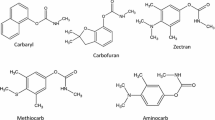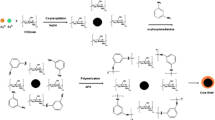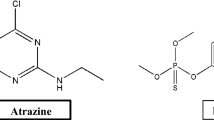Abstract
The present work describes novel chitosan-siloxane nano-sorbents (Ch-Si NS), including chitosan phenyl siloxane (Ch-PS NS), chitosan octa-decyl siloxane (Ch-ODS NS), and chitosan decyl siloxane (Ch-DS NS) for solid-phase extraction (SPE) and removal of seven pesticides from the water samples. Different chemical groups of pesticides, including abamectin, diazinon, fenamiphos, imidacloprid, lambda-cyhalothrin, methomyl, and thiophanate-methyl were examined in this study. The nano-sorbents were designed as core–shell particles based on the combination of silylation and cross-linking mechanism. The factorial design was used to optimize the retention variables (suitable elution system and sorbent amount). The chemical and morphological parameters of Ch-Si NS were characterized by Fourier transform infrared spectroscopy, scanning electron microscopy (SEM), X-ray diffraction, and Zeta Potential. The characterization results established the chemical structure and the conjugation between the nano-sphere layers (core–shell). SEM observed that the Ch-Si NS have a nano-spherical morphology, where the average size values were 206, 99, and 136 nm for Ch-PS NS, Ch-ODS NS, and Ch-DS NS, respectively. Moreover, the developed SPE cartridges provided good recognition and fast adsorption dynamics for the tested pesticides with good repeatability in the range of 0.21–8.86% and enrichment factor 2.91–8.81 µg/mL. Under the optimized conditions, the proposed SPE cartridges were successfully applied for pesticide extraction from water with high relative recoveries up to 99.54%. The validation parameters of the developed method provided a low limit of detection (0.02–0.46 µg/L) and limit of quantification (0.006–0.0154 µg/L).





Similar content being viewed by others
Data availability
All data generated or analysed during this study are included in this article. Also, the related datasets are available from the corresponding author on reasonable request.
References
Christos A, Damalas I, Ilias G (2011) “Pesticide exposure”. Safety issues, and risk assessment indicators. Int J Environ Res Public Health 8:1402–1419. https://doi.org/10.3390/ijerph8051402
EL-Saeid MH, Alghamdi AG (2020) Identification of pesticide residues and prediction of their fate in agricultural soil. Water Air Soil Pollut 231:1–10. https://doi.org/10.1007/s11270-020-04619-6
Mahmood I, Imadi SR, Shazadi K, Gul A, Hakeem KR (2016) Effects of pesticides on environment. In: Plant, soil and microbes. Springer, pp 253–269
Badawy ME, El-Nouby MA, Marei AE-SM (2018) Development of a solid-phase extraction (SPE) cartridge based on chitosan-metal oxide nanoparticles (Ch-MO NPs) for extraction of pesticides from water and determination by HPLC. Int J Anal Chem. https://doi.org/10.1155/2018/3640691
Tankiewicz M, Fenik J, Biziuk M (2010) Determination of organophosphorus and organonitrogen pesticides in water samples. TrAC Trends Anal Chem 29:1050–1063. https://doi.org/10.1016/j.trac.2010.05.008
Vela N, Calín M, Yáñez-Gascón MJ, el Aatik A, Garrido I, Pérez-Lucas G, Fenoll J, Navarro S (2019) Removal of pesticides with endocrine disruptor activity in wastewater effluent by solar heterogeneous photocatalysis using ZnO/Na2S2O8. Water Air Soil Pollut 230:1–11. https://doi.org/10.1007/s11270-019-4185-y
Atigh ZBQ, Sardari P, Moghiseh E, Lajayer BA, Hursthouse AS (2021) Purified montmorillonite as a nano-adsorbent of potentially toxic elements from environment: an overview. Nanotechnol Environ Eng 6:1–21. https://doi.org/10.1007/s41204-021-00106-3
Zuloaga O, Navarro P, Bizkarguenaga E, Iparraguirre A, Vallejo A, Olivares M, Prieto A (2012) Overview of extraction, clean-up and detection techniques for the determination of organic pollutants in sewage sludge: a review. Anal Chim Acta 736:7–29. https://doi.org/10.1016/j.aca.2012.05.016
Font G, Manes J, Molto J, Picó Y (1993) Solid-phase extraction in multi-residue pesticide analysis of water. J Chromatogr 642:A135-161. https://doi.org/10.1016/0021-9673(93)80083-K
Jenkins TF, Miyares PH, Myers KF, McCormick EF, Strong AB (1994) Comparison of solid phase extraction with salting-out solvent extraction for preconcentration of nitroaromatic and nitramine explosives from water. Anal Chim Acta 289:69–78. https://doi.org/10.1016/0003-2670(94)80009-X
Thurman E, Mills M (1998) Solid-phase extraction, vol 29. Wiley, New York, pp 35–73. https://doi.org/10.1002/(SICI)1097-0231(19980731)12:14<988::AID-RCM265>3.0.CO;2-1
Campone L, Piccinelli AL, Celano R, Pagano I, Russo M, Rastrelli L (2018) Rapid and automated on-line solid phase extraction HPLC–MS/MS with peak focusing for the determination of ochratoxin A in wine samples. Food Chem 244:128–135. https://doi.org/10.1016/j.foodchem.2017.10.023
Hennion M-C (1999) Solid-phase extraction: method development, sorbents, and coupling with liquid chromatography. J Chromatogr 856:A3-54. https://doi.org/10.1016/S0021-9673(99)00832-8
Tamura T (2013) Solid-phase extraction cartridge. Google Patents
Melo LF, Collins CH, Jardim IC (2005) High-performance liquid chromatographic determination of pesticides in tomatoes using laboratory-made NH2 and C18 solid-phase extraction materials. J Chromatogr 1073:A75-81. https://doi.org/10.1016/j.chroma.2004.09.043ch
Schenck FJ, Lehotay SJ, Vega V (2002) Comparison of solid-phase extraction sorbents for cleanup in pesticide residue analysis of fresh fruits and vegetables. J Sep Sci 25:883–890. https://doi.org/10.1002/1615-9314(20021001)25:14%3c883::AID-JSSC883%3e3.0.CO;2-7
Naghdi M, Metahni S, Ouarda Y, Brar SK, Das RK, Cledon M (2017) Instrumental approach toward understanding nano-pollutants. Nanotechnol Environ Eng. https://doi.org/10.1007/s41204-017-0015-x
Dittmar T, Koch B, Hertkorn N, Kattner G (2008) A simple and efficient method for the solid-phase extraction of dissolved organic matter (SPE-DOM) from seawater. Limnol Oceanogr Methods 6:230–235. https://doi.org/10.4319/lom.2008.6.230
Kumrić K, Vujasin R, Egerić M, Petrović Đ, Devečerski A, Matović L (2019) Coconut shell activated carbon as solid-phase extraction adsorbent for preconcentration of selected pesticides from water samples. Water Air Soil Pollut 230:1–10. https://doi.org/10.1007/s11270-019-4359-7
Badawy ME, Rabea EI (2017) Chitosan and its modifications as biologically active compounds in different applications. Adv Physicochem Prop Biopolym Part 2:1–108
Badawy ME, Rabea EI, Taktak NE, El Nouby MA (2016) Production and properties of different molecular weights of chitosan from marine shrimp shells. J Chitin Chitosan Sci 4:46–54. https://doi.org/10.1166/jcc.2016.1097
Dehaghi SM, Rahmanifar B, Moradi AM, Azar PA (2014) Removal of permethrin pesticide from water by chitosan–zinc oxide nanoparticles composite as an adsorbent. J Saudi Chem Soc 18:348–355. https://doi.org/10.1016/j.jscs.2014.01.004
Kyzas GZ, Bikiaris DN (2015) Recent modifications of chitosan for adsorption applications: a critical and systematic review. Mar Drugs 13:312–337. https://doi.org/10.3390/md13010312
Lu LC, Wang CI, Sye WF (2011) Applications of chitosan beads and porous crab shell powder for the removal of 17 organochlorine pesticides (OCPs) in water solution. Carbohydr Polym 83:1984–1989. https://doi.org/10.1016/j.carbpol.2010.11.003
Yu W, Wang Y, Gnutt P, Wanka R, Krause LM, Finlay JA, Clare AS, Rosenhahn A (2021) Layer-by-layer deposited hybrid polymer coatings based on polysaccharides and zwitterionic silanes with marine antifouling properties. ACS Appl Bio Mater 4:2385–2397. https://doi.org/10.1021/acsabm.0c01253
Varghese JG, Karuppannan RS, Kariduraganavar MY (2010) Development of hybrid membranes using chitosan and silica precursors for pervaporation separation of water+ isopropanol mixtures. J Chem Eng Data 55:2084–2092. https://doi.org/10.1021/je9003993
Eldeeb TM, El Nemr A, Khedr M, El-Dek S (2021) Efficient removal of Cu (II) from water solution using magnetic chitosan nanocomposite. Nanotechnol Environ Eng 6:1–15. https://doi.org/10.1007/s41204-021-00129-w
Badawy ME, Marei AESM, El-Nouby MA (2018) Preparation and characterization of chitosan-siloxane magnetic nanoparticles for the extraction of pesticides from water and determination by HPLC. Sep Sci Plus 1:506–519. https://doi.org/10.1002/sscp.201800084
Chatterjee S, Gupta A, Mohanta T, Mitra R, Samanta D, Mandal AB, Majumder M, Rawat R, Singha NR (2018) Scalable synthesis of hide substance–chitosan–hydroxyapatite: novel biocomposite from industrial wastes and its efficiency in dye removal. ACS Omega 3:11486–11496. https://doi.org/10.1021/acsomega.8b00650
Cass QB, Bassi AL, Matlin SA (1996) Chiral discrimination by HPLC on aryl carbamate derivatives of chitin coated onto microporous aminopropyl silica. Chirality 8:131–135
Bordianu-Antochi IE, Olaru M, Cotofana C (2017) Novel hybrid formulations based on chitosan and a siloxane compound intended for biomedical applications. React Funct Polym 114:118–126. https://doi.org/10.1016/j.reactfunctpolym.2017.03.013
Fuentes S, Retuert J, Benavente E, Lozano H, Gonzalez G (2008) Chitosan-siloxane nanocomposites. Formation, structure, and properties of films. Mol Cryst Liq Cryst 483:109–119. https://doi.org/10.1080/15421400801900755
Lu F, Astruc D (2018) Nanomaterials for removal of toxic elements from water. Coord Chem Rev 356:147–164. https://doi.org/10.1016/j.ccr.2017.11.003
Rawtani D, Khatri N, Tyagi S, Pandey G (2018) Nanotechnology-based recent approaches for sensing and remediation of pesticides. J Environ Manag 206:749–762. https://doi.org/10.1016/j.jenvman.2017.11.037
Elgarahy AM, Elwakeel KZ, Akhdhar A, Hamza MF (2021) Recent advances in greenly synthesized nanoengineered materials for water/wastewater remediation: an overview. Nanotechnol Environ Eng 6:1–24. https://doi.org/10.1007/s41204-021-00104-5
Gahukar RT, Das RK (2020) Plant-derived nanopesticides for agricultural pest control: challenges and prospects. Nanotechnol Environ Eng 5:1–9. https://doi.org/10.1007/s41204-020-0066-2
Kalambettu AB, Rajangam P, Dharmalingam S (2012) The effect of chlorotrimethylsilane on bonding of nano hydroxyapatite with a chitosan–polyacrylamide matrix. Carbohydr Res 352:143–150. https://doi.org/10.1016/j.carres.2011.12.027
Enescu D, Hamciuc V, Pricop L, Hamaide T, Harabagiu V, Simionescu BC (2009) Polydimethylsiloxane-modified chitosan I. Synthesis and structural characterisation of graft and crosslinked copolymers. J Polym Res 16:73–80. https://doi.org/10.1007/s10965-008-9204-4
Li Z, Li J, Wang Y, Wei Y (2014) Synthesis and application of surface-imprinted activated carbon sorbent for solid-phase extraction and determination of copper (II). Spectrochim Acta Part A Mol Biomol Spectrosc 117:422–427. https://doi.org/10.1016/j.saa.2013.08.045
Urasa IT, Macha SF, El-Maaty W (1997) Application of solid-phase extraction in metal speciation. J Chromatogr Sci 35:519–524. https://doi.org/10.1093/chromsci/35.11.519
Procedures A (2000) Methods validation: chemistry, manufacturing, and controls. Federal Register (Notices), pp 776–65
Corportation I (2017) IBM SPSS Statistics for Windows (Version 25.0 Armonk). IBM Corp., Armonk
Yang J, Liao M, Hong G, Dai S, Shen J, Xie H, Chen C (2020) Effect of APTES-or MPTS-conditioned nanozirconia fillers on mechanical properties of Bis-GMA-based resin composites. ACS Omega 5:32540–32550
Gao Y, Lee K-H, Oshima M, Motomizu S (2000) Adsorption behavior of metal ions on cross-linked chitosan and the determination of oxoanions after pretreatment with a chitosan column. Anal Sci 16:1303–1308. https://doi.org/10.2116/analsci.16.1303
Putri R, Lim LW, Takeuchi T (2018) Separation of dansyl amino acids in capillary liquid chromatography using cyclodextrin-bonded chiral monolithic stationary phases. G P Glob Res J Chem
Ebisike K, Okoronkwo AE, Alaneme KK (2018) Synthesis and characterization of Chitosan–silica hybrid aerogel using sol–gel method. J King Saud Univ Sci. https://doi.org/10.1016/j.jksus.2018.08.005
Le Zhang X, Niu HY, Zhang SX, Cai YQ (2010) Preparation of a chitosan-coated C 18-functionalized magnetite nanoparticle sorbent for extraction of phthalate ester compounds from environmental water samples. Anal Bioanal Chem 397:791–798. https://doi.org/10.1007/s00216-010-3592-0
Chau HTC, Kadokami K, Ifuku T, Yoshida Y (2017) Development of a comprehensive screening method for more than 300 organic chemicals in water samples using a combination of solid-phase extraction and liquid chromatography-time-of-flight-mass spectrometry. Environ Sci Pollut Res 24:26396–26409. https://doi.org/10.1007/s11356-017-9929-x
Chidya RC, Abdel-Dayem SM, Takeda K, Sakugawa H (2018) Spatio-temporal variations of selected pesticide residues in the Kurose River in Higashi-Hiroshima city, Japan. J Environ Sci Health Part B 53:602–614 https://doi.org/10.1080/03601234.2018.1473972
García MG, Dahane S, Arrabal-Campos F, SociasViciana M, García M, Fernández I, Galera MM (2017) MCM-41 as novel solid phase sorbent for the pre-concentration of pesticides in environmental waters and determination by microflow liquid chromatography-quadrupole linear ion trap mass spectrometry. Microchem J 134:181–190. https://doi.org/10.1016/j.microc.2017.06.008
Han Q, Aydan T, Yang L, Zhang X, Liang Q, Ding M (2018) In-syringe solid-phase extraction for on-site sampling of pyrethroids in environmental water samples. Anal Chim Acta 1009:48–55. https://doi.org/10.1016/j.aca.2018.01.001
Peng L-Q, Ye L-H, Cao J, Y-x Chang Q, Li M An, Tan Z, Xu J-J (2017) Cyclodextrin-based miniaturized solid phase extraction for biopesticides analysis in water and vegetable juices samples analyzed by ultra-high-performance liquid chromatography coupled with quadrupole time-of-flight mass spectrometry. Food Chem 226:141–148. https://doi.org/10.1016/j.foodchem.2017.01.006
Yang X, Zhang P, Li X, Hu L, Gao H, Zhang S, Zhou W, Lu R (2016) Effervescence-assisted β-cyclodextrin/attapulgite composite for the in-syringe dispersive solid-phase extraction of pyrethroids in environmental water samples. Talanta 153:353–359. https://doi.org/10.1016/j.talanta.2016.03.007
Zhou T, Ding J, He Z, Li J, Liang Z, Li C, Li Y, Chen Y, Ding L (2018) Preparation of magnetic superhydrophilic molecularly imprinted composite resin based on multi-walled carbon nanotubes to detect triazines in environmental water. Chem Eng J 334:2293–2302. https://doi.org/10.1016/j.cej.2017.11.185
Acknowledgements
The authors acknowledge and thank the Misr El Kheir Foundation: Science, Technology, and Innovation (STI) Program to support and fund this work under the Project code LGA05130114.
Author information
Authors and Affiliations
Corresponding author
Ethics declarations
Conflict of interest
The authors confirm that this article's content has no conflict of interest.
Additional information
Publisher's Note
Springer Nature remains neutral with regard to jurisdictional claims in published maps and institutional affiliations.
Rights and permissions
About this article
Cite this article
El-Nouby, M.A.M., Badawy, M.E.I. & Marei, A.ES.M. Performance evaluation of functionalized chitosan-siloxane nano-sorbents for pesticides extraction and removal from aqueous samples. Nanotechnol. Environ. Eng. 6, 44 (2021). https://doi.org/10.1007/s41204-021-00139-8
Received:
Accepted:
Published:
DOI: https://doi.org/10.1007/s41204-021-00139-8




